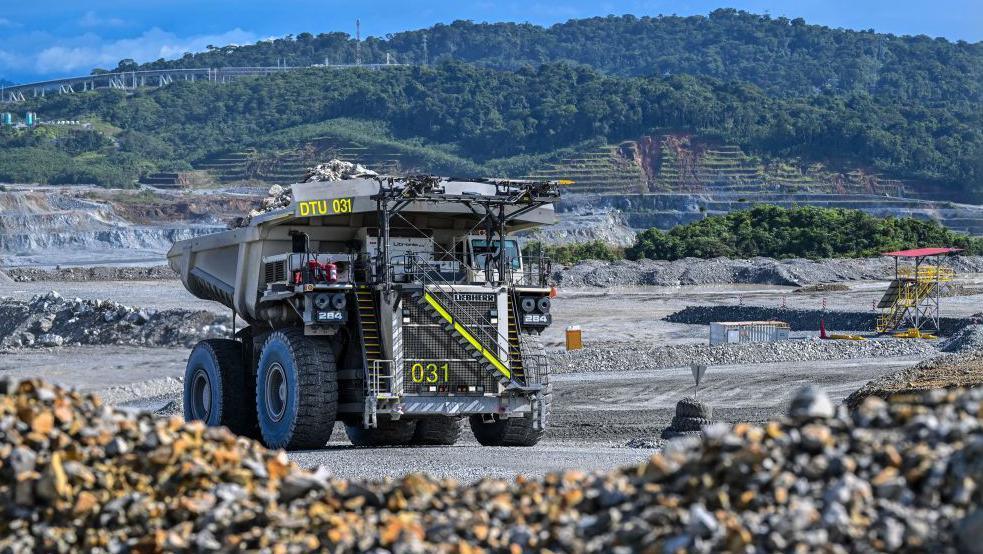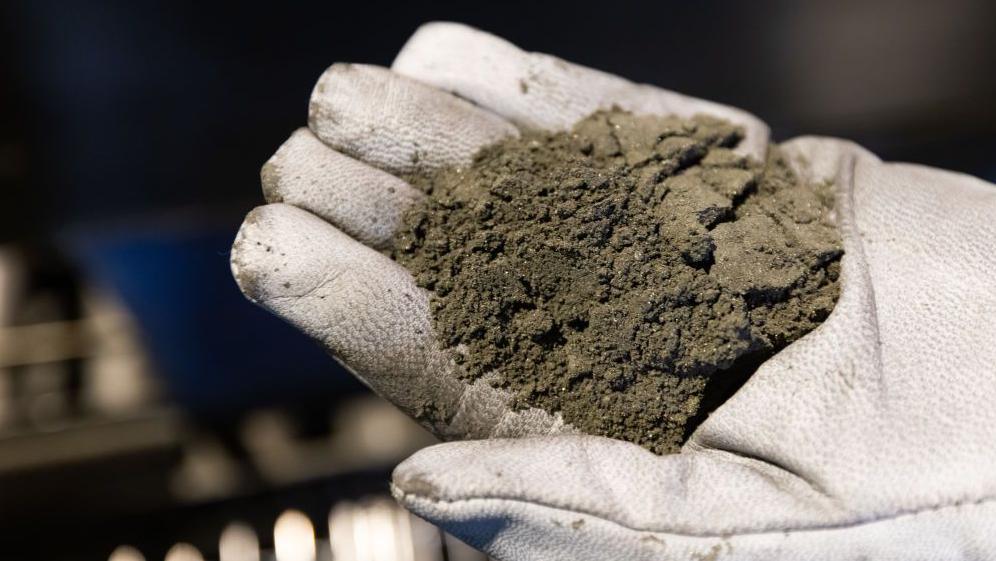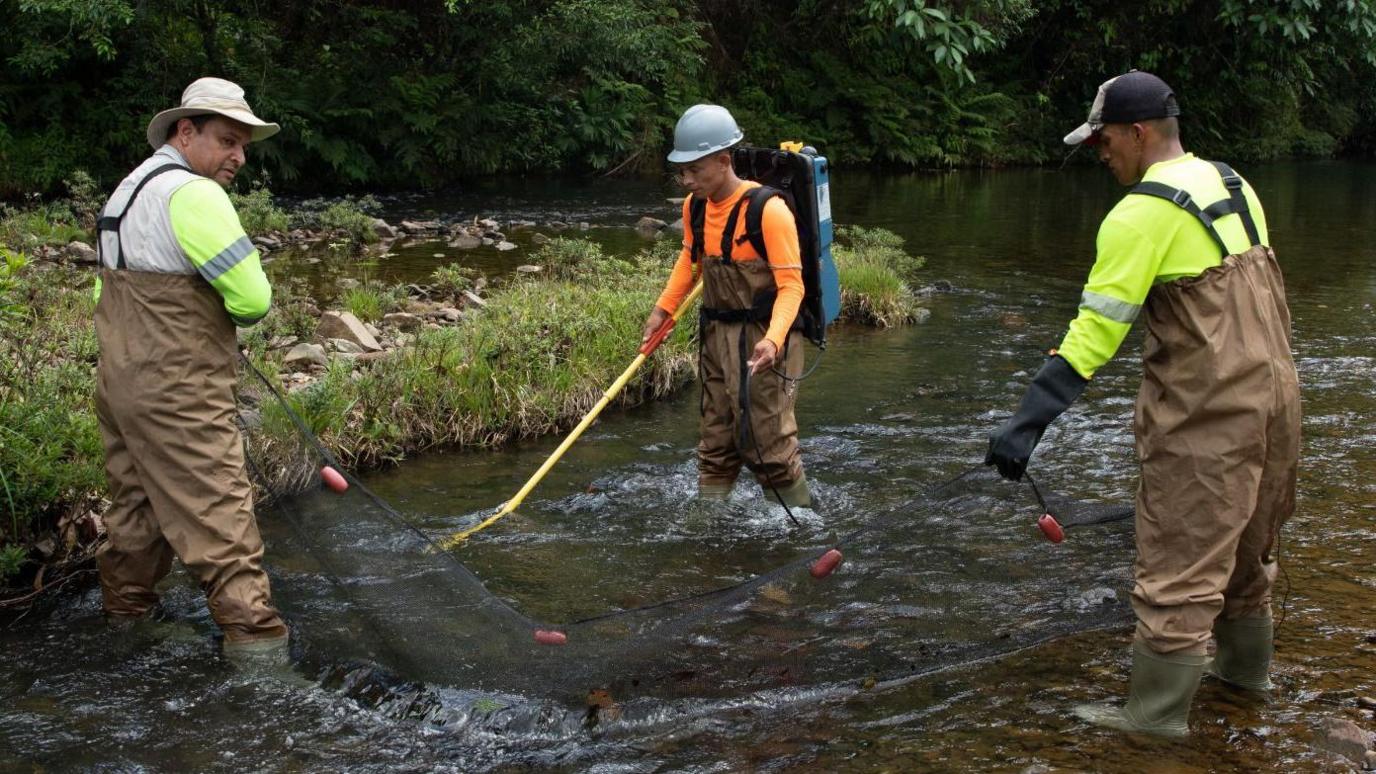Concerns over 'dangerous gases' at closed copper mine

The Cobre Panamá mine was forced to close in December
- Published
Zorel Morales is worried about 130,000 tonnes of toxic material.
The substance in question is partially processed copper ore, and it has been stuck at a closed copper mine in Panama since the end of last year.
“The chemical reactions that generate dangerous gases, and a rise in the material’s temperatures, pose environmental risks,” says Mr Morales, who is the head of Panama’s Chamber of Mining. He adds that it “threatens the health and safety of staff” still working at the operation.
The substance, called “copper concentrate”, is finely ground copper ore that has been treated to increase its copper content ahead of going on to be exported for smelting into refined copper.
In addition to the danger of the release of toxic sulphur dioxide gas, just being exposed to dust particles from the concentrate can damage, external a person’s respiratory system. And it is toxic to aquatic life.
The material has been left at the site of Cobre Panamá, a huge open pit copper mine closed since last December, when the country’s supreme court ruled that a new 20-year concession to operate the facility was unconstitutional.
After the ruling the government quickly forced the mine to shut, leaving just maintenance staff at the facility.
The order came after thousands of people took to the nation’s streets last October and November to protest against the mine, which they said was harming the environment.
The facility, one of the world’s largest copper mines, employed some 7,000 people, and accounted for 1% of the world’s copper production. It opened in 2019, and is owned by Canadian firm First Quantum Minerals.
Listen now - Panama's troubled copper mine
Located deep in a tropical rainforest near Panama’s Caribbean Coast, First Quantum has invested $10bn (£7.8bn) in the mine, including new infrastructure like roads, buildings and machinery.
The company wants to be able to export the existing concentrate. It has filed two international arbitration claims against Panama, although it says that its preferred route is to open dialogue with the new Panamanian government that came to power in July.
The dispute over the concentrate centres on who owns it – the Canadian company or Panama.
“We look forward to continuing to work with the new government to address the situation in relation to the mine,” says First Quantum spokesperson Maru Gálvez, in a statement.
“In particular, it is important to resolve the status of the copper concentrate that remains at the mine site and which all parties have agreed is an urgent matter.”
In response, a government spokesman says they are still assessing the situation and aren’t giving interviews. The new president, José Raúl Mulino, has yet to give a clear message about how he wants to resolve the issue.

Copper concentrate, pictured, is very finely ground copper ore that has been partially processed
One of Panama’s former finance ministers, Dulcidio de la Guardia, says he is frustrated by the situation.
“Cobre Panamá was the most important foreign investment in the country, second to the Panama Canal,” says Mr la Guardia, who held that cabinet position from 2014 to 2019. “It accounted for 5% of the GDP, which is around $5bn in direct and indirect contributions to the economy.”
Michael Camacho is a leader of the Utramipa mining union, and one of 1,400 people still working at Cobre Panamá as part of the maintenance programme. This is costing First Quantum about $15m to $20m a month.
Mr Camacho wants to see the government approve a plan for the preservation and safe operation of the mine. “In December more than 6,000 miners were left out of work when operations stopped. I urge the new president, José Raúl Mulino, to listen to the concerns of the communities around the mine who want to go back to work.”
But, environmental activist Raisa Banfield, who was involved in the demonstrations that led to the mine’s closure, is adamant that it remaining shut is in the best interests of the country. “The future of Panama isn’t from mining. The future of Panama is its biodiversity.”
She thinks the country needs a new kind of business model. “I think we’re re-finding our identity away from big projects like the Panama Canal, and foreign companies taking our resources to satisfy their economic model.”
She and other demonstrators got support from climate activist Greta Thunberg and Hollywood actor Leonardo Di Caprio, who both shared a video, external calling for the “mega mine” to stop its operations.
Ms Banfield wants the new government to instead invest in infrastructure for eco-tourism so Panama can flourish like neighbouring Costa Rica.
Yet others think the mine’s closure wasn’t just about the environment. Samuel Valdés is a biologist and the owner of the Biodiversity Consultant Group, which was employed by First Quantum to do studies to help minimise the environmental impact of the vast facility.
“There’s been a lot of misinformation surrounding the mine,” he says. Mr Valdés argues that some of the opposition to the facility was an extension of suspicions about the former government.
“Many people thought the last government was corrupt, and so they started to mistrust the mine’s [perceived close] relationship with it.”
He adds that the rivers surrounding the mine are thriving due to copious rainfall and all his reports show that fish, algae and prawns flourish there and are public for anyone to see. However, he accepts that on occasion there have been isolated incidents that affected specific areas.
He thinks there are also tensions between different moral viewpoints.
“The fight against the mine was from people who live in the cities who have a fixed idea of how people who live in the countryside should be living. Having worked with local people for the last 10 years I can tell you that their lives were much better because of the mine.”

Samuel Valdés, left, regularly tests water quality near the mine
It’s estimated that about 40,000 people relied on the mine for their income, when you add firms that provided it with services. Mr Valdés had to make 60 people redundant – many of them scientists - when the facility closed.
He says the issue of leftover copper concentrate was caused by the mine having to immediately close down. “The problem here is that the mine was a bit like a busy kitchen that suddenly closed. The food was left out on the sides or in the oven. Processes had been stopped mid-cycle”.
Some argue that the mine should be opened again, but only so that it can then be closed down again in a more orderly manner. Mr Valdés, as you’d imagine, wants to see it restart production, and then remain open.
All this uncertainty isn’t helping Panama’s reputation as a country for international investment. The ratings agency Fitch stripped Panama of its investment grade credit rating because of the closure of the copper mine undermining economic growth.
It remains to be seen if Panama’s new government will both regain investors’ confidence – and permanently reopen the mine.
Panama orders controversial copper mine's closure
- Published29 November 2023